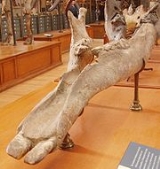
Archaeobelodon
Encyclopedia
Archaeobelodon is an extinct genus of proboscidea
of the family Gomphotheriidae endemic to Europe
and Africa
during the Miocene
from 16.9—16.0 Ma, living for approximately .
Archaeobelodon was an ancestor of Platybelodon
and Amebelodon
. Archaeobelodon had a trunk and tusk
s.
Proboscidea
Proboscidea is a taxonomic order containing one living family, Elephantidae, and several extinct families. This order was first described by J. Illiger in 1881 and encompasses the trunked mammals...
of the family Gomphotheriidae endemic to Europe
Europe
Europe is, by convention, one of the world's seven continents. Comprising the westernmost peninsula of Eurasia, Europe is generally 'divided' from Asia to its east by the watershed divides of the Ural and Caucasus Mountains, the Ural River, the Caspian and Black Seas, and the waterways connecting...
and Africa
Africa
Africa is the world's second largest and second most populous continent, after Asia. At about 30.2 million km² including adjacent islands, it covers 6% of the Earth's total surface area and 20.4% of the total land area...
during the Miocene
Miocene
The Miocene is a geological epoch of the Neogene Period and extends from about . The Miocene was named by Sir Charles Lyell. Its name comes from the Greek words and and means "less recent" because it has 18% fewer modern sea invertebrates than the Pliocene. The Miocene follows the Oligocene...
from 16.9—16.0 Ma, living for approximately .
Archaeobelodon was an ancestor of Platybelodon
Platybelodon
Platybelodon was a genus of large herbivorous mammal related to the elephant . It lived during the Miocene Epoch, about 15-4 million years ago, and ranged over Africa, Europe, Asia and North America...
and Amebelodon
Amebelodon
Amebelodon is a member of a diverse group of primitive proboscideans called gomphotheres, a group that also gave rise to the modern elephants and their close relative the mammoth. The most striking attribute of this animal is its lower tusks, which are narrow, elongated,and distinctly flattened...
. Archaeobelodon had a trunk and tusk
Tusk
Tusks are elongated, continuously growing front teeth, usually but not always in pairs, that protrude well beyond the mouth of certain mammal species. They are most commonly canines, as with warthogs, wild boar, and walruses, or, in the case of elephants and narwhals, elongated incisors...
s.

